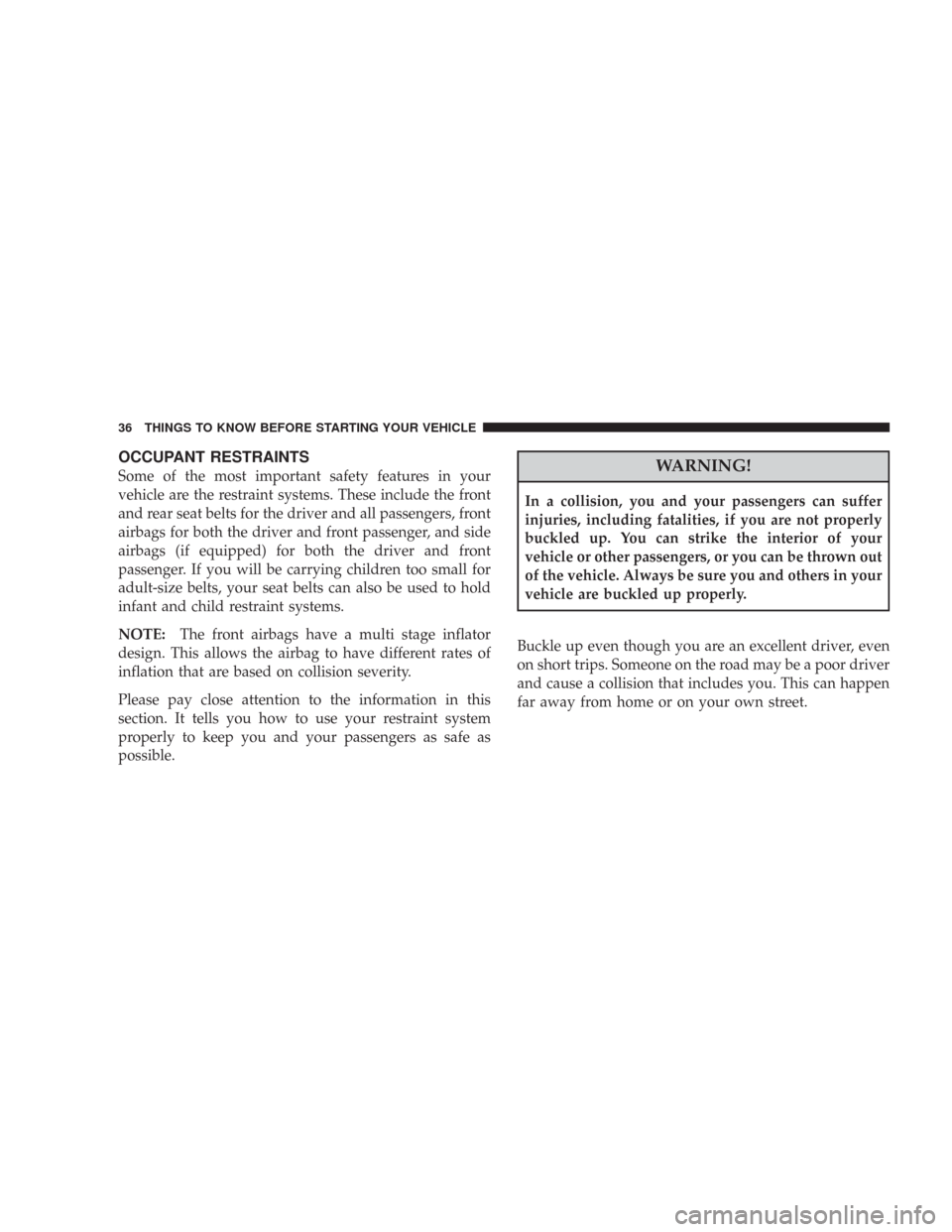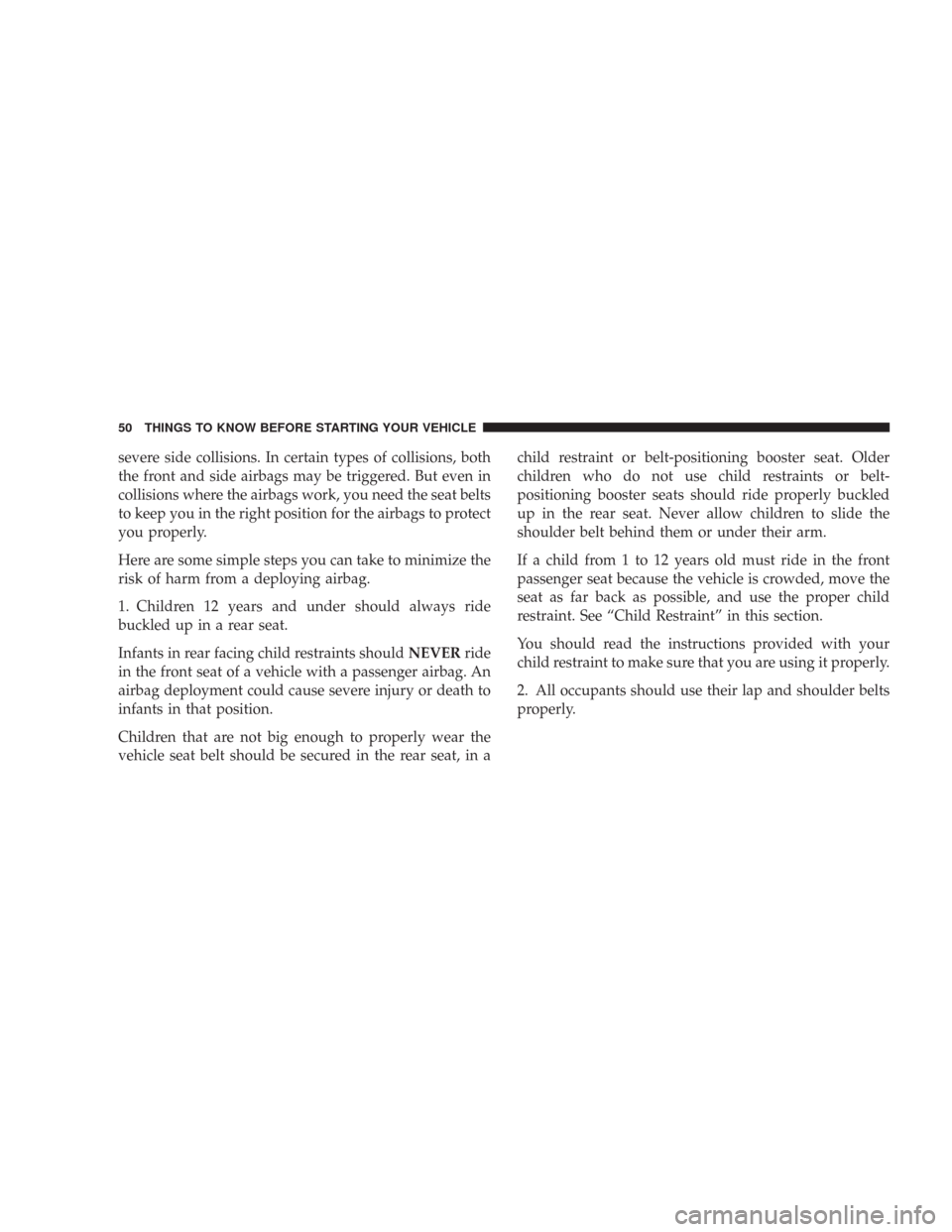Page 36 of 467

OCCUPANT RESTRAINTS
Some of the most important safety features in your
vehicle are the restraint systems. These include the front
and rear seat belts for the driver and all passengers, front
airbags for both the driver and front passenger, and side
airbags (if equipped) for both the driver and front
passenger. If you will be carrying children too small for
adult-size belts, your seat belts can also be used to hold
infant and child restraint systems.
NOTE:The front airbags have a multi stage inflator
design. This allows the airbag to have different rates of
inflation that are based on collision severity.
Please pay close attention to the information in this
section. It tells you how to use your restraint system
properly to keep you and your passengers as safe as
possible.WARNING!
In a collision, you and your passengers can suffer
injuries, including fatalities, if you are not properly
buckled up. You can strike the interior of your
vehicle or other passengers, or you can be thrown out
of the vehicle. Always be sure you and others in your
vehicle are buckled up properly.
Buckle up even though you are an excellent driver, even
on short trips. Someone on the road may be a poor driver
and cause a collision that includes you. This can happen
far away from home or on your own street.
36 THINGS TO KNOW BEFORE STARTING YOUR VEHICLE
Page 44 of 467

WARNING!
Position the shoulder belt height adjusters so that the
belt rests across the middle of your shoulder. Failure
to adjust the safety belt properly could reduce the
effectiveness of the seat belt and increase the risk of
injury in a collision.
As a guide, if you are shorter than average, you will
prefer a lower position, and if you are taller than average,
you’ll prefer a higher position. When you release the
anchorage, try to move it up or down to make sure that
it is locked in position.
Seat Belt Pretensioners
The driver and front passenger seat belts are equipped
with a pretensioning device that is designed to remove
any slack from the seat belt systems in the event of a
collision. This device improves the performance of the
seat belt by assuring that the belt is tight around the
occupant early in a collision. Pretensioners work for all
size occupants, including those in child restraints.
NOTE:These devices are not a substitute for proper seat
belt placement by the occupant. The seat belt must still be
worn snugly and positioned properly.
The pretensioners are triggered by the Occupant Re-
straint Control (ORC) Module. Like the front airbags, the
pretensioners are a single use item. After a collision that
is severe enough to deploy the airbags and pretensioners,
they must be replaced.
44 THINGS TO KNOW BEFORE STARTING YOUR VEHICLE
Page 47 of 467
WARNING!
Using a seat belt extender when not needed can
increase the risk of injury in a collision. Only use
when the seat belt is not long enough when it is worn
low and snug, and in the recommended seating
positions. Remove and stow the seat belt extender
when not needed.
Driver And Front Passenger Supplemental
Restraint Systems (SRS)
Front Airbag Components
THINGS TO KNOW BEFORE STARTING YOUR VEHICLE 47
2
Page 48 of 467

This vehicle has airbags for both the driver and right
front passenger as a supplement to the seat belt restraint
systems. The driver’s front airbag is mounted in the
steering wheel. The passenger side airbag is mounted in
the instrument panel, above the glove compartment. The
words SRS/AIRBAG are embossed on the airbag covers.
NOTE:The front airbags are certified to the Federal
regulations that allow less forceful deployment.
The front airbags have a multistage inflator design. This
may allow the airbag to have different rates of inflation
that are based on collision severity and occupant size.
Also, the front passenger airbag is certified to the Federal
regulations that define Occupant Classification (Refer to
�Occupant Classification System�in this section).
If the vehicle is equipped with side airbags, they are
located inside the driver and front passenger seats, and
their covers are also labeled SRS/AIRBAG.NOTE:Airbag covers may not be obvious in the interior
trim; but they will open to allow airbag deployment.
Side Airbag Location
48 THINGS TO KNOW BEFORE STARTING YOUR VEHICLE
Page 49 of 467

WARNING!
•Do not put anything on or around the front airbag covers
or attempt to manually open them. You may damage the
airbags and you could be injured because the airbags are
no longer functional. These protective covers for the
airbag cushions are designed to open only when the
airbags are inflating.
•If your vehicle is equipped with side airbags, do not use
accessory seat covers or place objects between you and
the side airbags; the performance could be adversely
affected and/or objects could be pushed into you, caus-
ing serious injury.
•If your vehicle is equipped with side airbags, do not
attach cup holders or any other objects on or around the
door. The inflating side airbag could drive the objects
into occupants, causing serious injury.
•Do not cover or place items on the airbag covers. These
items may cause serious injury during inflation.
•Do not store or place items under the front seats. You
may damage the airbag wiring harnesses.
The front airbags have a multi stage inflator design. This
allows the airbag to have different rates of inflation that
are based on collision severity. Along with the seat belts,
front airbags work with the instrument panel knee bol-
sters to provide improved protection for the driver and
front passenger. Side airbags also work with seat belts to
improve occupant protection.
The seat belts are designed to protect you in many types
of collisions. The front airbags deploy in moderate to
severe frontal collisions.
NOTE:The passenger front airbag may not deploy even
when the driver front airbag has if the Occupant Classi-
fication System (refer to�Occupant Classification System�
in this section) has determined the passenger seat is
empty or is occupied by someone that is classified in the
�small child�category.
If your vehicle is so equipped, the side airbag on the
crash side of the vehicle is triggered in moderate to
THINGS TO KNOW BEFORE STARTING YOUR VEHICLE 49
2
Page 50 of 467

severe side collisions. In certain types of collisions, both
the front and side airbags may be triggered. But even in
collisions where the airbags work, you need the seat belts
to keep you in the right position for the airbags to protect
you properly.
Here are some simple steps you can take to minimize the
risk of harm from a deploying airbag.
1. Children 12 years and under should always ride
buckled up in a rear seat.
Infants in rear facing child restraints shouldNEVERride
in the front seat of a vehicle with a passenger airbag. An
airbag deployment could cause severe injury or death to
infants in that position.
Children that are not big enough to properly wear the
vehicle seat belt should be secured in the rear seat, in achild restraint or belt-positioning booster seat. Older
children who do not use child restraints or belt-
positioning booster seats should ride properly buckled
up in the rear seat. Never allow children to slide the
shoulder belt behind them or under their arm.
If a child from 1 to 12 years old must ride in the front
passenger seat because the vehicle is crowded, move the
seat as far back as possible, and use the proper child
restraint. See “Child Restraint” in this section.
You should read the instructions provided with your
child restraint to make sure that you are using it properly.
2. All occupants should use their lap and shoulder belts
properly.
50 THINGS TO KNOW BEFORE STARTING YOUR VEHICLE
Page 51 of 467

3. The driver and front passenger seats should be moved
back as far as practical to allow the front airbags room to
inflate.
4. If your vehicle has side airbags, do not lean against the
door, airbags will inflate forcefully into the space be-
tween you and the door.
5. If the airbag system in this vehicle needs to be
modified to accommodate a disabled person, contact the
Customer Center. Phone numbers are provided under “If
You Need Assistance” in Section 9 of this manual.WARNING!
•Relying on the airbags alone could lead to more
severe injuries in a collision. The airbags work
with your seat belt to restrain you properly. In
some collisions the airbags won’t deploy at all.
Always wear your seat belts even though you have
airbags.
•Being too close to the steering wheel or instrument
panel during airbag deployment could cause seri-
ous injury. Airbags need room to inflate. Sit back,
comfortably extending your arms to reach the
steering wheel or instrument panel.
•If the vehicle has side airbags, they also need room
to inflate. Do not lean against the door. Sit upright
in the center of the seat.
THINGS TO KNOW BEFORE STARTING YOUR VEHICLE 51
2
Page 52 of 467

Airbag System Components
The airbag system consists of the following:
•Occupant Restraint Control Module
•Airbag Warning Light
•Driver Airbag
•Passenger Airbag
•Front Seat Mounted Side Airbags (If Equipped)
•Steering Wheel and Column
•Instrument Panel
•Interconnecting Wiring
•Knee Impact Bolsters
•Front Acceleration Sensors
•Driver and Front Passenger Seat Belt Pretensioner
•Occupant Classification System (OCS) — Front Pas-
senger Seat Only
�Occupant Classification Module
�Passenger Airbag Disable (PAD) Indicator Light
�Weight Sensors
How The Airbag System Works
•
TheOccupant Restraint Control (ORC) Modulede-
termines if a frontal, or side collision is severe enough
to require the front and/or side airbags to inflate. The
front airbag inflators are designed to provide different
rates of airbag inflation from direction provided by the
ORC. The ORC may also modify the rate of inflation
based on the occupant size provided by the Occupant
Classification Module.
52 THINGS TO KNOW BEFORE STARTING YOUR VEHICLE